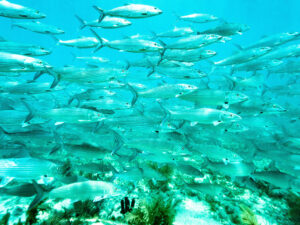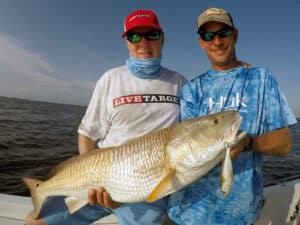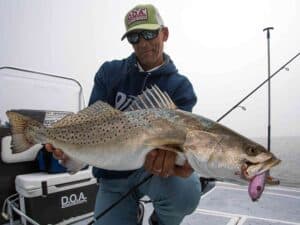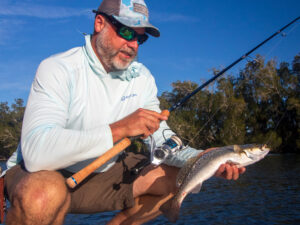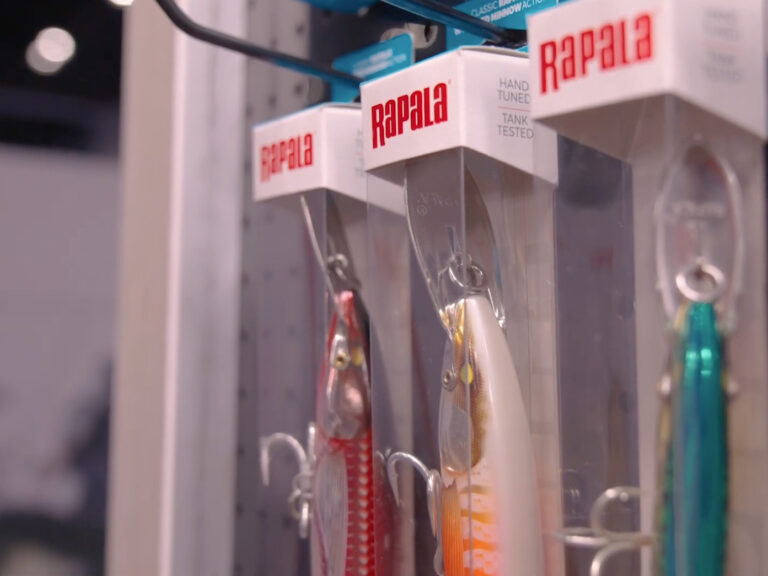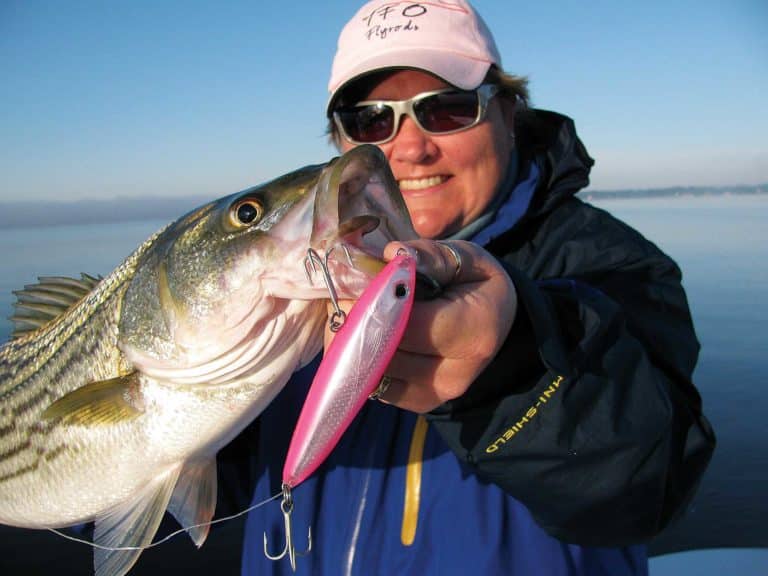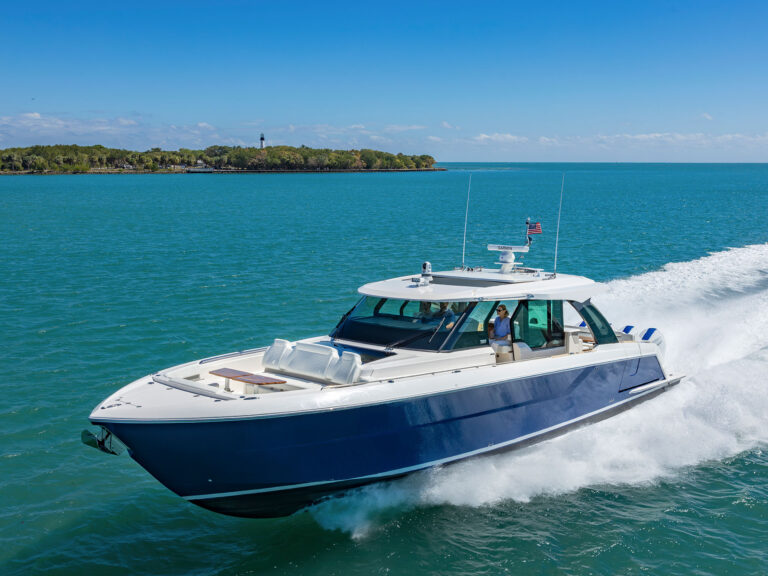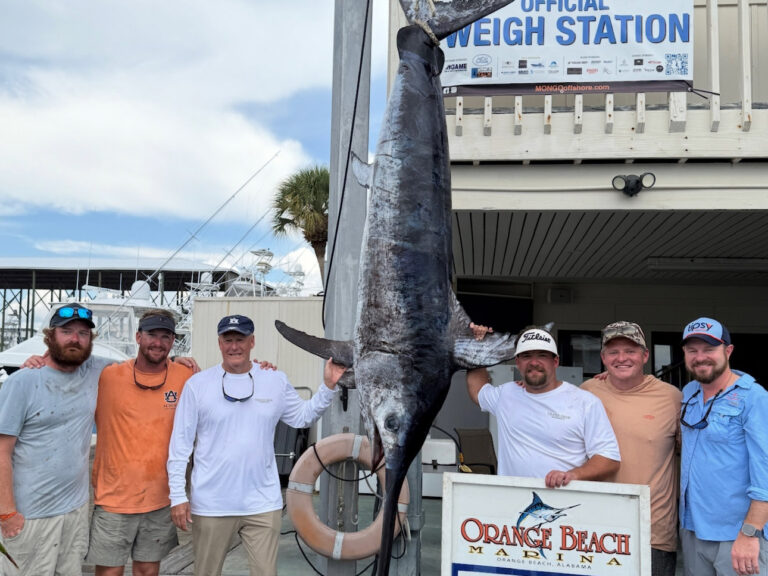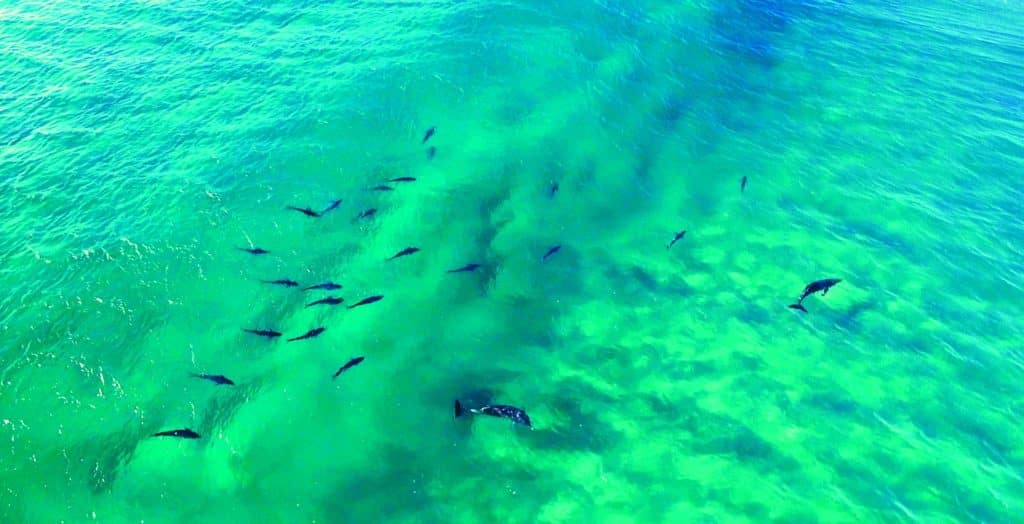
A video earlier this year showed anglers catching longtail tuna after a drone places their baits 400 yards off a beach in New South Wales, Australia. It has millions of views, so you might have seen it. In any case, the video (see photo above) shows just one of many possibilities that drones might offer for fishing in the future. For example, for beach anglers like those guys after longtails, midprice drones are capable of holding a bait on the surface and providing the resistance needed to release a kite clip. On the other hand, the roughly 20-minute battery life — less when carrying a heavy bait — limits drone use somewhat.

A drone’s built-in camera provides spectacular fishing photography. But even beyond that, the overhead view and territory-covering ability are perfect for scouting for fish, scrutinizing topography, and illuminating nuances of fish behavior. Those applications make it somewhat surprising that, thus far, few top anglers are actually using drones to bend rods and bring more fish boat-side.
For a clear view of the benefits and limitations of drones for fishing, I persuaded seven pro fishermen and photographers to share their tips for finding more fish, enticing more bites, and capturing better images using the drone’s-eye view.
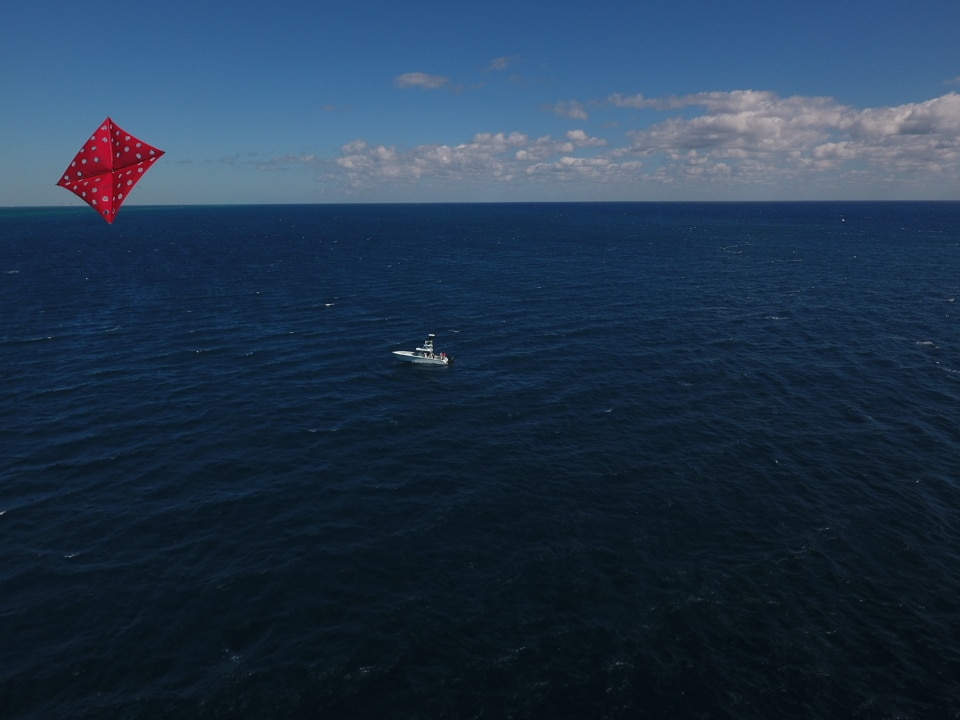
“I’ll put the drone up about 100 feet from the kite and a little above it, and point the camera down toward the baits,” says Capt. Mike Weinhofer, a Key West fishing guide. “I can see sailfish a minute or more before the bite, 15 or 20 feet underwater, just swimming circles around the bait.” But drone battery life limits such views to brief glimpses. Weinhofer likens drone use to cameras on trolled dredges. “We’re seeing things we couldn’t see before. It’s amazing how many fish swim up to a dredge, or with the drone, how many fish circle the kite bait, and then just fade away. It’s a window into what’s happening. It gets you wondering about how to improve your presentation.”

A fishier use for drones — which Weinhofer says is both practical and productive enough that he’s banned the use of drones in the six-figure-stakes Florida Keys Dolphin Championship and Final Sail tournaments he directs — is in spotting predators near the surface. In the Florida Keys, when seas stir up shallow sand near the reef line, sailfish often patrol where green water meets blue Gulf Stream water. “Here in Key West, sailfish swim east to west on the surface, so put the drone up to the east of you, about 200 feet above the water, and fly along the color-change line,” Weinhofer says. “It’s surprising how easily you can see the black shadows [of fish]. Particularly in the green water, they stand out like neon signs.”
But, he says, flying a drone while keeping kites up and baits out often isn’t worth the effort: “It really takes a dedicated pilot just to fly the drone and watch that camera. Do it when the bite slows down. Maybe you’re fishing on the blue side, but you’ll find the fish on the green side.” He also suggests aerial scanning to find the sharpest water-color contrast, which condenses fish into a tighter area.
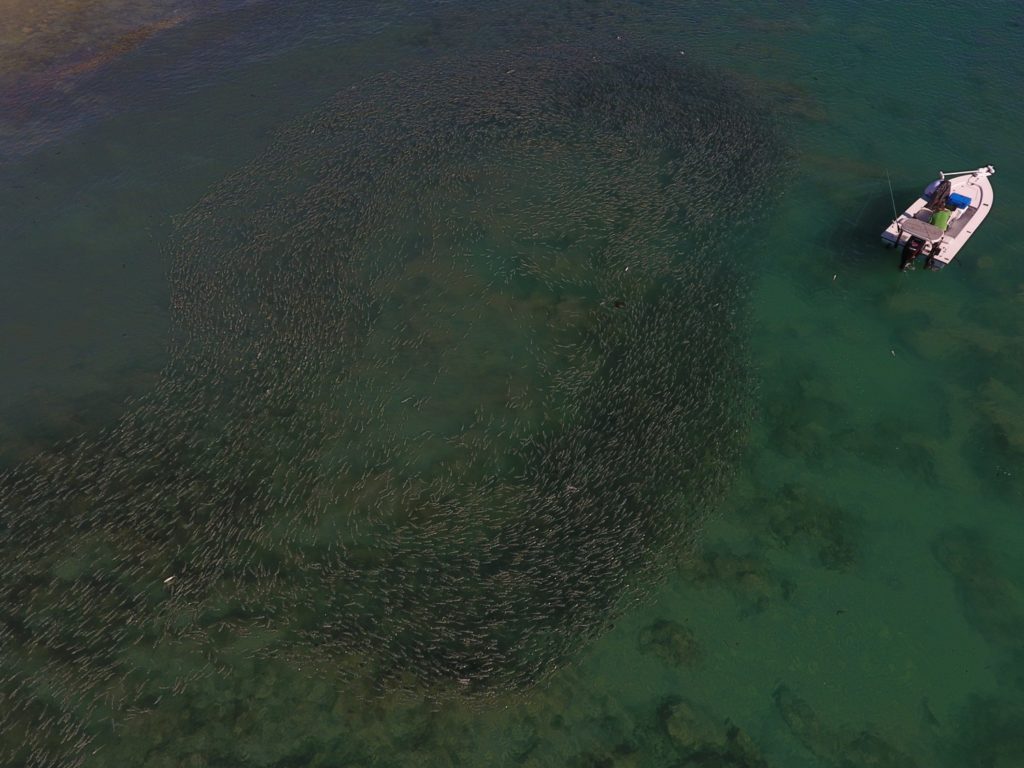
Given the limited field of vision of drones’ cameras, scouting works best along defined features, rather than by randomly searching the open sea. Scanning just off the beach on Florida’s east coast, for example, a drone can spot shallow-water bait schools that draw snook, tarpon, sharks and even sailfish, as well as the large rays that cobia often follow. Without a defined feature to reconnoiter, Weinhofer might fly a drone over water a little shallower or a little deeper than he’s fishing, since sailfish often favor one specific depth contour on any given day. “You could be 200 yards off a hot bite and miss it entirely,” he says.
Inshore fishing also benefits from aerial views. “I’m old-school. I like to hunt. I like to use my skills to figure it out,” says Capt. Rob Fordyce, an Islamorada guide, and host of the Outdoor Channel’s The Seahunter. “But if I fly the drone over a half-mile of flat that I just fished, there are often a lot more fish there that I saw with the drone, but not while I was fishing. They’re either deeper or shallower than I thought they should have been for the conditions that day.”

Fordyce points out that using this drone perspective before poling a flat or working down a shoreline could give anglers a real advantage: “Run a drone down and back in 20 minutes, and you’d see what’s there.”
Although Fordyce’s TV show heavily utilizes drone footage, he eschews drone use to aid fishing. “I have use of half a dozen drones at any given time, but I’ve yet to use one to find fish or make my day easier, because I enjoy the hunt,” he says. Fordyce feels drones can diminish the inshore-fishing experience. “It’s like the days before GPS. I learned the Everglades, hundreds of bays and shorelines, by going slow. I learned more about the fish. I learned where the little-bit-deeper spots were with a push pole. With the drone, you might see where the fish are on one particular day, but you’re not learning about that topography, the intricacies of the flat [that] you learn if you pole it or go slow with a trolling motor.”
On the other hand, Fordyce says: “Whether you’re a beginner or an experienced fisherman in an area you’ve never fished, a drone could definitely quicken the learning phase. Pole part of that flat, but then take the last 20 minutes and run the same area with the drone. Keep records of the wind direction, the barometer, the tide, and remember where you saw fish on those particular conditions.” But, he cautions, “I just don’t think it’s wise to use a drone as your sole demeanor of learning.”

Much farther north, another professional skipper offers a slightly different take. “It can take many fishing trips to know the lay of the land,” says Capt. Chris Valaskatgis, a Massachusetts fishing guide. “But throw a drone up, and you see the whole thing laid out.” When first launching his boat in the spring, Valaskatgis surveys local inlets by drone to learn how they’ve changed through a winter of storms. “I’m looking for new cuts that are deep enough to troll through, and also points and curves within those cuts that congregate fish. They might be subtle, maybe 3 or 4 feet underwater. We don’t have strong current, so you’d never see that from the boat, but they’re obvious from the drone.”
He checks again as the season develops. In one instance, Valaskatgis was having success with smallish striped bass by working the current edge formed by an estuary sandbar. “From the drone, we noticed the current was curving past the bar, not flowing the way you’d think,” he says. Knowing bigger fish stake out the best spots, Valaskatgis made an adjustment. “It was subtle, maybe 50 yards, but all of a sudden we were catching much bigger fish.”
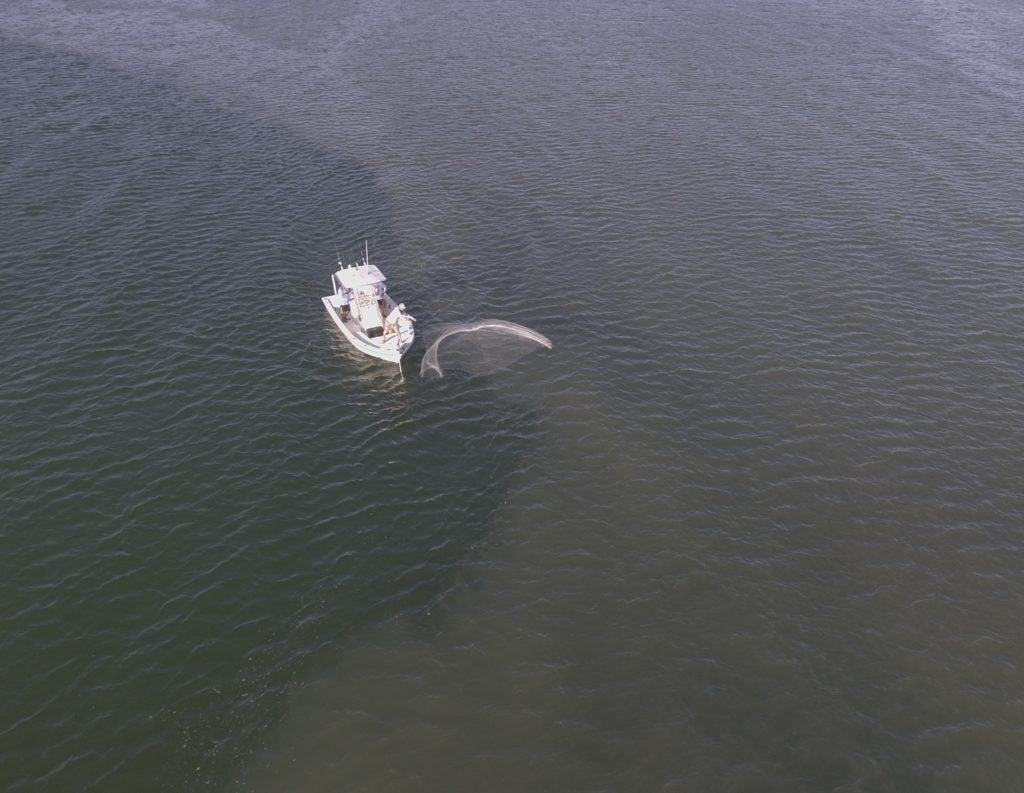
Drones also help anglers better understand their quarry. “For a long time, our best glimpse into fundamental fish behavior was from underwater and aerial footage on nature shows,” says Capt. Jay Shields, a Massachusetts guide and fishing-media producer. “Now, with that eye-in-the-sky perspective from drones, we can see patterns and interpret fish behavior. When I find a large biomass, before I fish, sometimes I’ll put the drone high overhead and watch how predators and prey are interacting.” Shields noticed, for instance, a particular feeding pattern of false albacore (little tunny): “The fish you see breaking the surface are maybe 15 percent of the school. The other 85 percent are patrolling the edges, keeping that baitball tight.” Fish actively feasting often didn’t respond to his bait, but by studying the drone view, he learned to target those fish on the perimeter. “Your bait stands out to those herders,” he says. “They’re looking for baits coming off the ball.”
From the air, Chris Valaskatgis says, a similar pattern is obvious with most bait schools. “You might see bait flipping in a 10-foot-by-10-foot area, but throw the drone up,” he says, “and you see the bait school is actually 50-by-50.” By approaching those baits breaking the surface to start fishing, he says, you’re often driving right over the top of the predators lurking along edges of the larger bait school.

Aerial video often clarifies anglers’ already-held beliefs. By studying footage from above of tuna biting spreader bars, Jay Shields confirmed that smaller fish come in from the side to feed, while larger fish tend to come straight up from beneath. “Anywhere you have structure,” he adds, “the fish up-current are typically the ones actively feeding. The fish you mark on the down-current side have shut off.”
Overhead views also offer new insights. When flying his drone over flats, bars and boulder fields, Shields has noticed distinctive paths where fish consistently travel and other paths they avoid, “like game trails,” he says, even though these areas showed no telltale signs from the boat or the drone. Similarly, studying drone footage of bird flocks flying near fish schools has helped Shields better interpret that interaction whenever it unfolds.
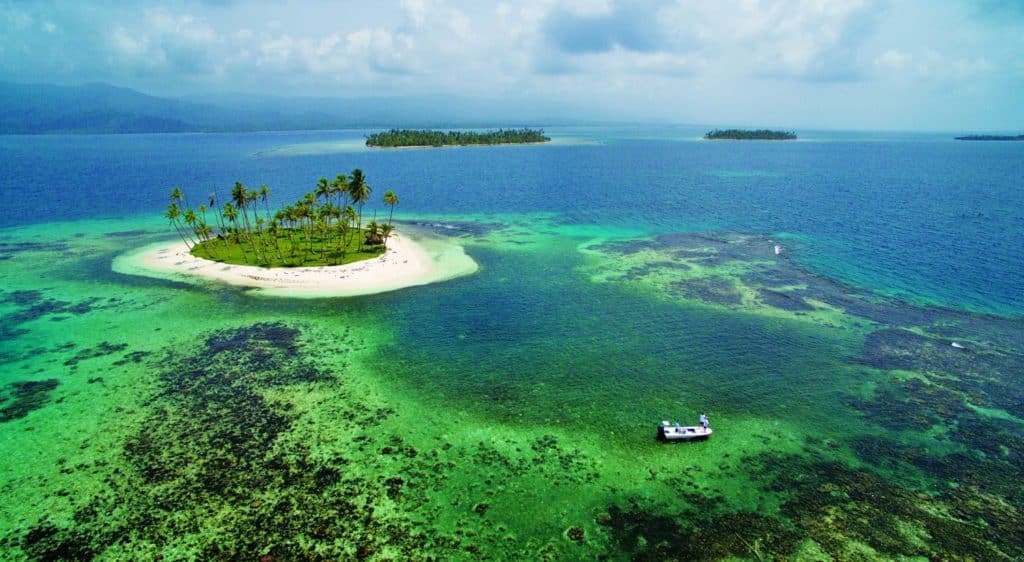
The key is applying general knowledge to specific situations. “The drone is like a close-up Google Earth perspective,” Capt. Shields says. “There may be five fingers off a sandbar that, from the boat, all look the same. But the drone shows one is a little deeper, or the drop-off a little steeper.” From his general understanding of fish, Shields says, “That deeper or steeper finger is what the biggest fish are going to converge on.”
Surprisingly, Mike Weinhofer doesn’t have much use for drones in scouting weed lines, as he feels that picking up birds on his radar gives him a clearer picture over a wider area of where fish are and which way they’re moving. Lone structure, like a floating log, is another story. “The fish can be 20 to 50 yards off that debris in any direction,” he says. The drone offers an opportunity to see those fish without spooking them. It’s also a chance to learn how those fish are interacting with free-floating structure. “To the fish, it’s a three-dimensional world, but from the deck of the boat, we don’t see fish down deep. The drone gives us the ability to see down into that third dimension.”
Expert Advice from a Drone Pilot

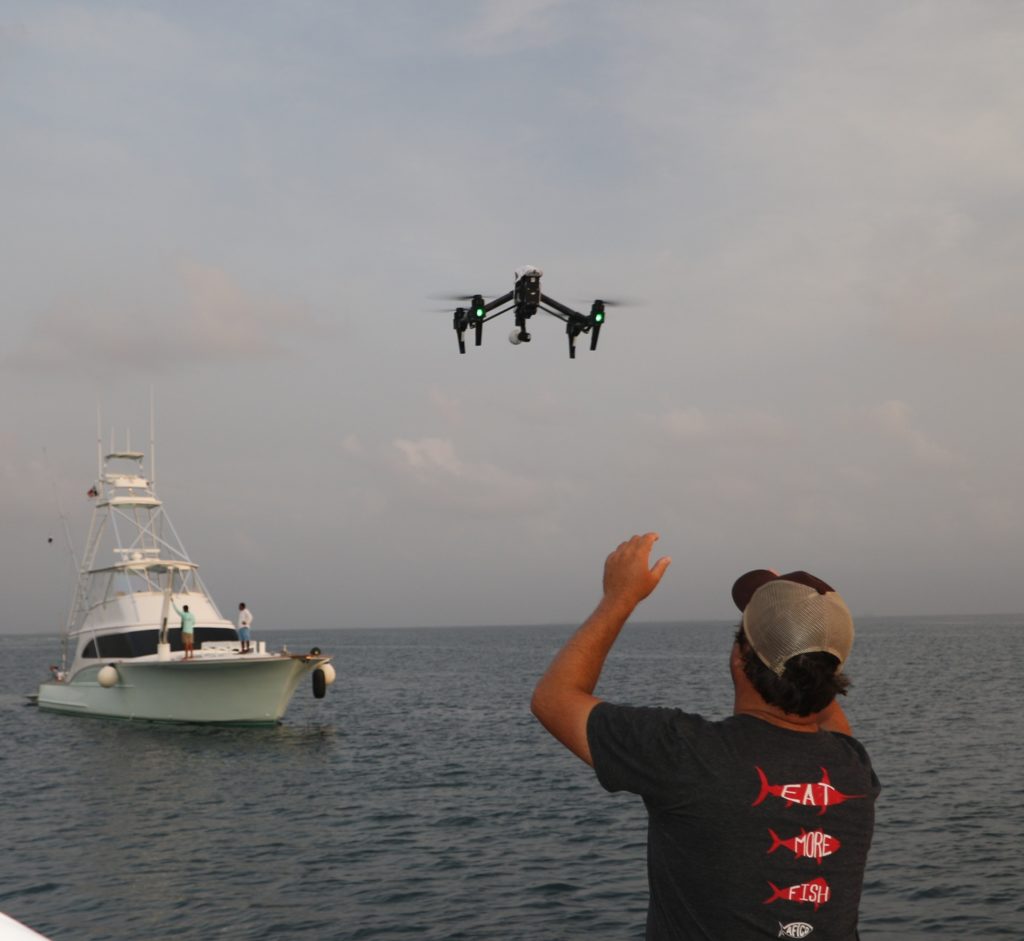
Tips from Drone-Flying Skippers
“As far as spooking fish, whether it’s bonefish or redfish tarpon, they don’t seem to care about the noise and vibration of the drone hovering over them. That surprised me,” Rob Fordyce says. “Even big tarpon in clear water will allow the drone to get 10 feet above them before even hinting that they’re bothered. But if the shadow of the drone goes near the fish, it will spook them. Keep in mind where the sun is in reference to the drone and the fish.”
Don’t get too close to birds, either, as Jay Shields has seen them become aggressive toward drones, and he lost one drone to a frigate attack. “It sank like a brick,” he says. “The last thing I saw was fire coming from the lithium battery [reacting to salt water].”

As drone use continues to explode, new fishing techniques will surely follow. “Times are changing,” Rob Fordyce says. “Technology — GPS, drones, going online to see where the currents are the morning before sailfishing — all those things can help you be more successful on the water if you learn how to use them, but you still have to have the basic skills fishermen had 50 years ago to make it all come together.”
Drones and the Law

In 2012, Congress passed a law allowing drone operation for “strictly hobby or recreational use … operated in accordance with a community-bases set of safety guidelines,” which for practical purposes means the Academy of Model Aeronautics guidelines. This past summer, separate Federal Aviation Administration regulations published under U.S. Code Title 14, Part 107, cover other drone use (find more info at faa.gov). “[For] anything that doesn’t meet the requirements of hobby aircraft, then 107 applies,” says Les Dorr, an FAA spokesperson on drones. “Either you operate under model aircraft guidance, or you operate under 107. There is no gray area.” The chief difference, as of August 2016, is the requirement for a drone pilot license for all nonhobbyists.
Anglers using drones to take photos or scout locations would be hobbyists; professional guides doing so to help their business would fall in the 107 area.
Other differences include a Part 107 requirement to obtain written FAA permission before flying in controlled airspace (typically within 4 miles of an airport), versus the hobbyist requirement to notify airports directly before operating within 5 miles. Part 107 drones also require individual registration numbers, while hobbyists register once to cover all owned aircraft. (Instruction is readily available through drone “flight schools.”)
The FAA’s new B4UFLY smartphone app (below) shows drone no-fly zones, which include airports, security zones (including most of Washington D.C.), and temporary security zones, such as within 3 miles of stadiums within an hour of major sporting events. Under separate rules, areas administered by the National Park Service also prohibit drones, including national parks, national seashores, national monuments and national memorials. The state of Oregon has also banned the use of drones to aid any hunting or fishing, including advanced scouting.
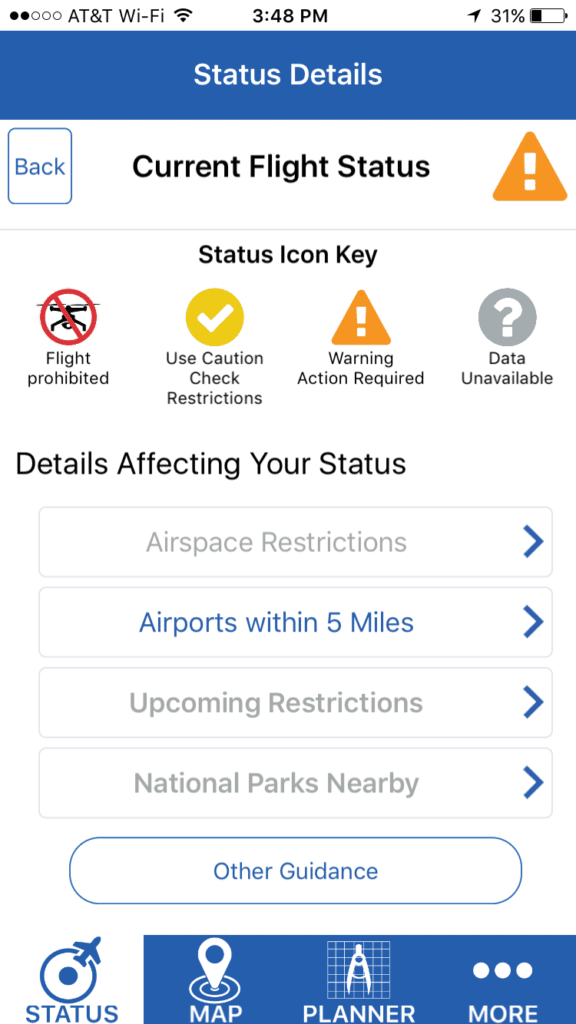
A Guide to Drone Perspectives for Fishing Photography
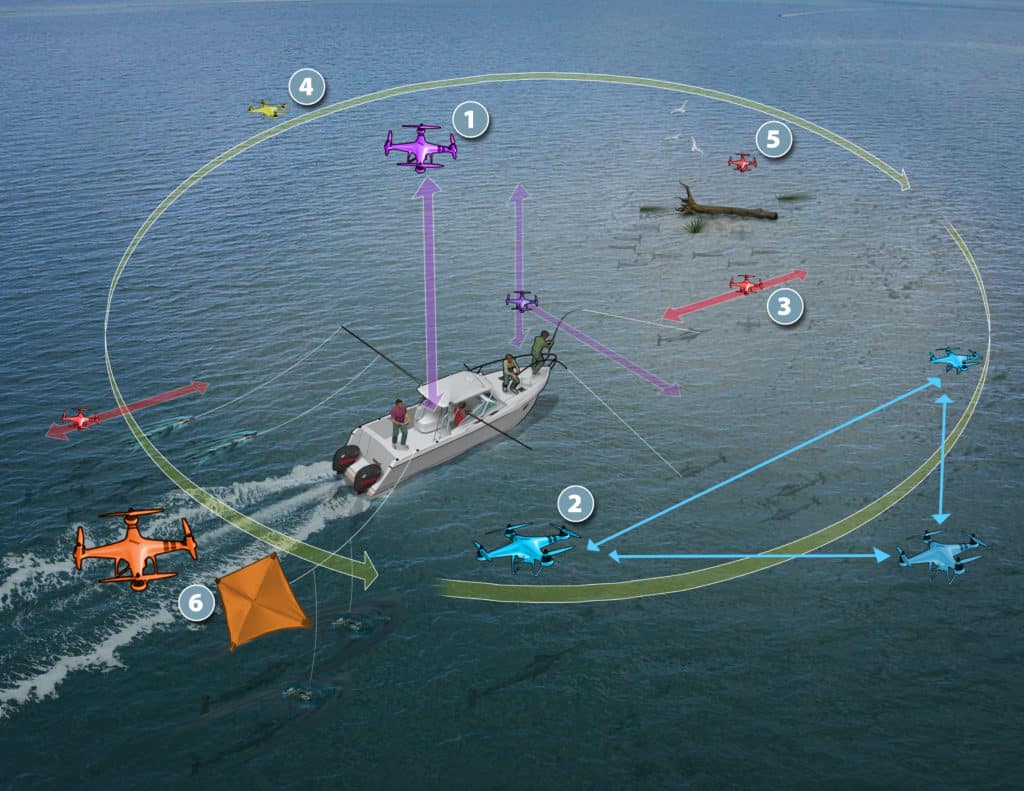
1) Start near eye level, 10 feet from the angler, and then fly straight back to reveal the vast ocean. Or start directly above the angler, camera shooting straight down, and then fly straight up to show the vast sea. Fly high over the boat, shooting straight down, to show fish far from the boat, or fly lower to show fish alongside. When pitching baits, fly directly over the boat, shooting toward the action.
2) To show fish yet be close enough to discern the captain’s and anglers’ actions, fly 40 to 60 feet from the boat. Follow with the drone as the angler moves from bow to stern. Start high and bring the drone down to eye level, rotating the camera so the boat stays centered in the frame. Or start low, with the angler or boat centered, and then fly straight up without tilting the camera to reveal the environment. With the boat at cruising speed, fly the drone so it keeps pace from behind, from in front, or while passing the boat.
3) Fly toward or away from the boat, or stay stationary and let the fish and boat pass beneath. Vary distance and framing.
4) Orbit a full 360 degrees around the boat, first 100 feet away and again 60 feet away.
5) Fly above and 20 feet beyond the kite, with the kite in the foreground and the boat in the background. Also shoot down at baits.
6) Keep all baits in the frame when trolling, but place the drone above debris before trolled baits reach it. Shoot both low- and high-altitude views of wrecks, debris, trolled baits, bait schools and birds to edit into the video later.
Tips for Shooting Video from Drones of Fish and Fishing
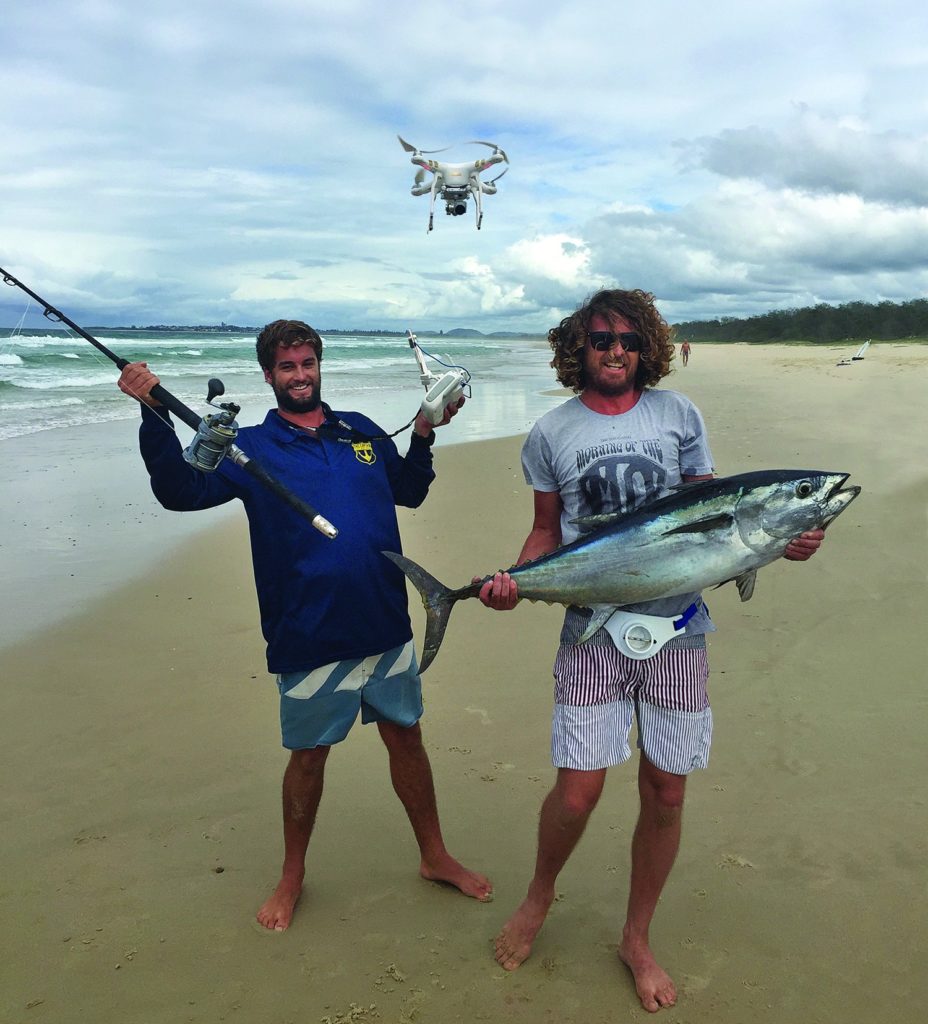
1) “Shoot 4k video,” says Wil Gonzalez, creative director for the Outdoor Channel’s The Seahunter. Those extra pixels allow for cropping or reframing the shot later, during editing. “The drone doesn’t have to get as close to the boat, the kite, antennas, outriggers or the angler. You can also get a wide establishing shot and then punch in to heighten the action” from the same camera shot, Gonzalez says. With double the pixels of 1080p high-definition video, 4k’s extra resolution also enhances still photos extracted from video later.
2) Show the camera moving to make it more engaging,” says Jay Shields. Cinematography staples include not just simple tilt (up and down), pan (side to side) and zoom (tighter or looser) from a stationary camera, but also “pedestal” or “jib” (camera moves straight up or down), “dolly” (camera moves directly toward or away), and “truck” (camera moves side to side).
3) “You’ve got to mix it up,” says frequent Sport Fishing photo contributor Jason Arnold. “Park the drone over a school of dolphin, show water moving, [or] shoot the sunrise or the sunset. Anything that shows nature, that’s all cool stuff” — which adds to the finished video.
4) “The pre-programmed settings on the newer drones are useful,” says Ryan Danoff, who often operates a drone for Arnold. “You’ll get the basic shot you’re looking for with those smart functions, but for more creative shots, you have to learn to fly manually.”

